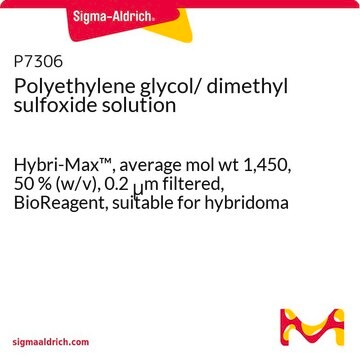8.07489
Polyethylene glycol
1500, for synthesis
Synonym(s):
Poly(ethylene glycol), Polyethylene glycol 1500, Polyglycol, Polyethylene oxide, Polyoxy ethylene, PEG 1500, PEG
About This Item
Recommended Products
vapor pressure
<0.01 hPa ( 20 °C)
Quality Level
form
solid
autoignition temp.
420 °C
potency
28000 mg/kg LD50, oral (Rat)
>20000 mg/kg LD50, skin (Rabbit)
pH
4-7 (20 °C, 100 g/L in H2O)
mp
43-49 °C
transition temp
flash point 260 °C
solubility
650 g/L
density
1.2 g/cm3 at 20 °C
bulk density
400‑500 kg/m3
storage temp.
2-30°C
SMILES string
C(CO)O
InChI
1S/C2H6O2/c3-1-2-4/h3-4H,1-2H2
InChI key
LYCAIKOWRPUZTN-UHFFFAOYSA-N
Looking for similar products? Visit Product Comparison Guide
Application
- A plasticizer in the synthesis of polylactic acid/talc composites to improve the crystallinity and mechanical properties of the material.
- A non-ionic surfactant in the preparation of organoclays.
- A reactant in the synthesis of quasi-prepolymers by reacting with a polymeric 4,4′-diphenylmethano diisocyanate (pMDI) via the pre-polymerization method.
PEG-1500 can also be used in the aqueous two-phase extraction system along with inorganic salts (sulfates, carbonates, and ammonium phosphates) for the separation and extraction of both organic (amino acids and vitamins) and inorganic substances (metal salts).
Analysis Note
Melting range (upper value): ≤ 49 °C
Hydroxyl value: 70 - 80
Average molecular mass: 1400 - 1600
Identity (IR): passes test
Storage Class Code
11 - Combustible Solids
WGK
WGK 1
Flash Point(F)
Not applicable
Flash Point(C)
Not applicable
Certificates of Analysis (COA)
Search for Certificates of Analysis (COA) by entering the products Lot/Batch Number. Lot and Batch Numbers can be found on a product’s label following the words ‘Lot’ or ‘Batch’.
Already Own This Product?
Find documentation for the products that you have recently purchased in the Document Library.
Customers Also Viewed
Our team of scientists has experience in all areas of research including Life Science, Material Science, Chemical Synthesis, Chromatography, Analytical and many others.
Contact Technical Service


